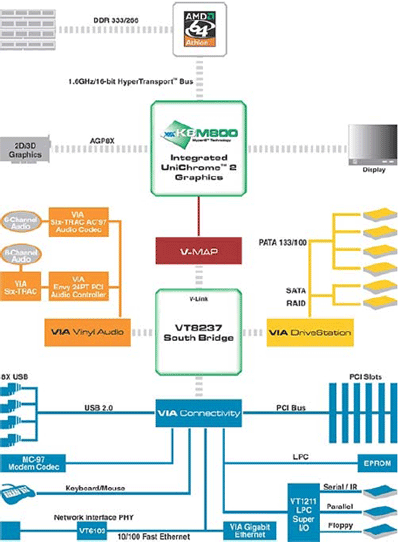Briefly, Hypertransport
replaces the numerous separate data and addressing lines used in the above
design with one or more Hypertransport Links for each direction. Each link will
carry data in the form of a packet which contains both the data and the address
it needs, while the Northbridge chip now takes on the role of organizing the
data it receives from the AGP interface and the Southbridge chip into these
Hypertransport packets and transmitting them across the link.
Hypertransport links can vary in both the speed
they operate and the amount of bits they transfer in each packet. Some
manufacturers have implemented a conventional bi-directional parallel bus
instead of Hypertransport to carry data between the Northbridge and the
Southbridge since the bandwidth requirements of the I/O subsystems linked to the
Southbridge are minimal compared to the needs of the memory and graphics
systems. More on this later. For a more in-depth examination of how
Hypertransport works, please see PCstats preview of the Athlon 64 itself.
All the chipsets for the Athlon64 support 8x AGP.
The VIA K8T800
VIA's
platform for the Opteron and the Athlon64 is the K8T800. It is
offered in two varieties, the Server/workstation version for the Opteron
Processor and the Performance PC platform for the Athlon64, both of which
use the VT8237 Southbridge.

The major selling point of the K8T800 chipset is
that it features a faster Hypertransport link (800Mhz DDR for
an effective 1.6Ghz) between the CPU and the chipset than the offerings
from the other companies.
As it uses
a 16-bit (meaning 16bits of data in each Hypertransport packet) link, this
enables the K8T800 to reach a maximum bandwidth of 3.2GB/s (1.6Ghz
* 16 / 8) in each direction for a rather impressive maximum
theoretical bandwidth of 6.4GB/s.
VIA argue that
problems with signal interference have made many of their competitors resort to using
lower speed implementations of Hypertransport, a problem which they have resolved with something
called Hyper8 technology. So it looks like Hypertransport will hopefully eliminate many
of the bottlenecks seen in current processor design, but with
the memory bus moved off the Northbridge, any link that provides more
than 3GBps will do.
